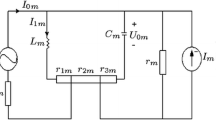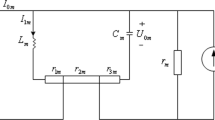Abstract
Among the theories of neural information coding, the neural energy coding is more accessible to global coding features than traditional neural encoding. According to the shortcomings existing in the neuronal energy model, that is, the non-smooth nature of the energy curve, we proposed an improved neuronal energy model in this paper. The modified energy model is a good choice for establishment of the global model of brain function. And it is also the basis of energy calculation for functional cognitive neural networks in the future.



Similar content being viewed by others
References
McLaughlin, D.W.: Ruling out and ruling in neural codes. Proc. Natl. Acad. Sci. (PNAS) 106(14), 5936–5941 (2009)
Velde, F.V.D., Kamps, M.D.: The necessity of connection structures in neural models of variable binding. Cogn. Neurodyn. 9(4), 1–12 (2015)
Kozma, R.: Reflections on a giant of brain science. Cogn. Neurodyn. 10(6), 457–469 (2016)
Tozzi, A., Peters, J.F.: Towards a fourth spatial dimension of brain activity. Cogn. Neurodyn. 10(3), 189–199 (2016)
Wang, R., Zhu, Y.: Can the activities of the large scale cortical network be expressed by neural energy–a brief review. Cogn. Neurodyn. 10(1), 1–5 (2016)
Laughlinl, S.B., Sejnowski, T.J.: Communication in neural networks. Science 301(5641), 1870–1873 (2003)
Abbott, L.F.: Theoretical neuroscience rising. Neuron 60(3), 489–495 (2008)
Wang, R., Tsuda, I., Zhang, Z.: A new work mechanism on neuronal activity. Int. J. Neural Syst. 25(03), 1450037 (2015)
Hyder, F., Rothman, D.L., Shulman, R.G.: Total neuroenergetics support localized brain activity: implications for the interpretation of fMRI. Proc. Natl. Acad. Sci. (PNAS) 99(16), 10771–10776 (2002)
Smith, A.J., Blumenfeld, H., Behar, K.L., Rothman, D.L., Shulman, R.G.: Cerebral energetics and spiking frequency: the neurophysiological basis of fMRI. Proc. Natl. Acad. Sci. (PNAS) 99(16), 10765–10770 (2002)
Raichle, M.E., Gusnard, D.A.: Appraising the brain’s energy budget. Proc. Natl. Acad. Sci. (PNAS) 99(16), 10237–10239 (2002)
Laughlin, S.B.: Energy as a constraint on the coding and processing of sensory information. Curr. Opin. Neurobiol. 11, 475–480 (2001)
Levy, W.B., Baxter, R.A.: Energy efficient neural codes. Neural Comp. 8(3), 531–543 (2003)
Fox, M.D., Raichle, M.E.: Spontaneous fluctuations in brain activity observed with functional magnetic resonance imaging. Nature 8, 700–711 (2007)
Bleton, H., Sejdić, E.: A cerebral blood flow evaluation during cognitive tasks following a cervical spinal cord injury: a case study using transcranial Doppler recordings. Cogn. Neurodyn. 9(6), 615–626 (2015)
Wang, R., Zhang, Z.: Mechanism on brain information processing: energy coding. Appl. Phys. Lett. (APL) 89(12), 123903 (2006)
Wang, R., Zhang, Z., Chen, G.: Energy coding and energy functions for local activities of brain. Neurocomputing 73(1–3), 139–150 (2009)
Wang, R., Zhang, Z., Chen, G.: Energy function and energy evolution on neural population. IEEE Trans. Neural Netw. 19(3), 535–538 (2008)
Wang, R., Wang, Z., Li, Y.: Neurodynamics analysis on neural energy encoding. Nonlinear Dyn. (Submitted) (2017)
Wang, Z., Wang, R.: Energy distribution property and energy coding of a structural neural network. Front. Comput. Neurosci. 8, 14 (2014)
Wang, R., Wang Z., Zhu, Z.: The dynamics property of neuronal activity from the consistency of two different neuron models. Nonlinear Dyn. (Submitted) (2017)
Wang, Z., Wang, R., Fang, R.: Energy coding in neural network with inhibitory neurons. Cogn. Neurodyn. 9(2), 129–144 (2015)
Lin, A., Fox, P.T., Hardies, J., Duong, T.Q., Gao, J.-H.: Nonlinear coupling between cerebral blood flow, oxygen consumption, and ATP production in human visual cortex. Proc. Natl. Acad. Sci. PNAS 107(18), 8447 (2010)
Qin, S., Yin, H., Yang, C., Dou, Y., Liu, Z., Zhang, P., Yu, H., Huang, Y., Feng, J., Hao, J., Hao, J., Deng, L., Yan, X., Dong, X., Zhao, Z., Jiang, T., Wang, H.-W., Luo, S.-J., Xie, C.: A magnetic protein biocompass. Nature Mater. 15, 217–226 (2016)
Zhang, Y., Pan, X., Wang, R.: Functional connectivity between prefrontal cortex and striatum estimated by phase locking value. Cogn. Neurodyn. 10, 245–254 (2016)
Zheng, H., Wang, R., Qu, J.: Effect of different glucose supply conditions on neuronal energy metabolism. Cogn. Neurodyn. 10(6), 563–571 (2016)
Wang, Y., Wang, R., Zhu, Y.: Optimal path-finding through mental exploration based on neural energy field gradients. Cogn. Neurodyn. 10(6), 1–13 (2016)
Zhang, H., Wang, Q., Perc, M., Chen, G.: Synaptic plasticity induced transition of spike propagation in neuronal networks. Commun. Nonlinear Sci. Numer. Simul. 18(3), 601–615 (2013)
Guo, D., Chen, M., Perc, M., et al.: Firing regulation of fast-spiking interneurons by autaptic inhibition. EPL 114(3), 30001 (2016)
Wang, Q., Chen, G., Perc, M.: Synchronous bursts on scale-free neuronal networks with attractive and repulsive coupling. PLoS One 6(1), e15851 (2010)
Guo, D., Wang, Q., Perc, M.: Complex synchronous behavior in interneuronal networks with delayed inhibitory and fast electrical synapses. Phys. Rev. E Stat. Nonlinear Soft Matter Phys. 85(1), 878–896 (2012)
Acknowledgements
This work is supported by the National Natural Science Foundation of China under (Grant Nos. 11232005, 11472104, 61633010 and 61473110).
Author information
Authors and Affiliations
Corresponding author
Appendix
Appendix
where


Rights and permissions
About this article
Cite this article
Wang, Y., Wang, R. An improved neuronal energy model that better captures of dynamic property of neuronal activity. Nonlinear Dyn 91, 319–327 (2018). https://doi.org/10.1007/s11071-017-3871-9
Received:
Accepted:
Published:
Issue Date:
DOI: https://doi.org/10.1007/s11071-017-3871-9




